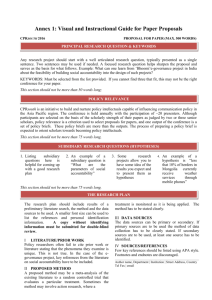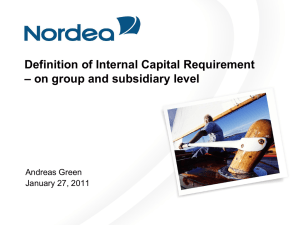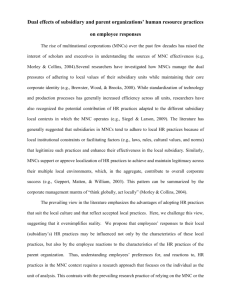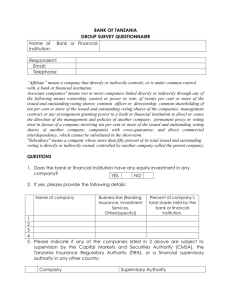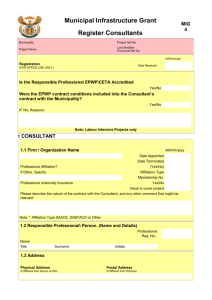Chapter 15
advertisement
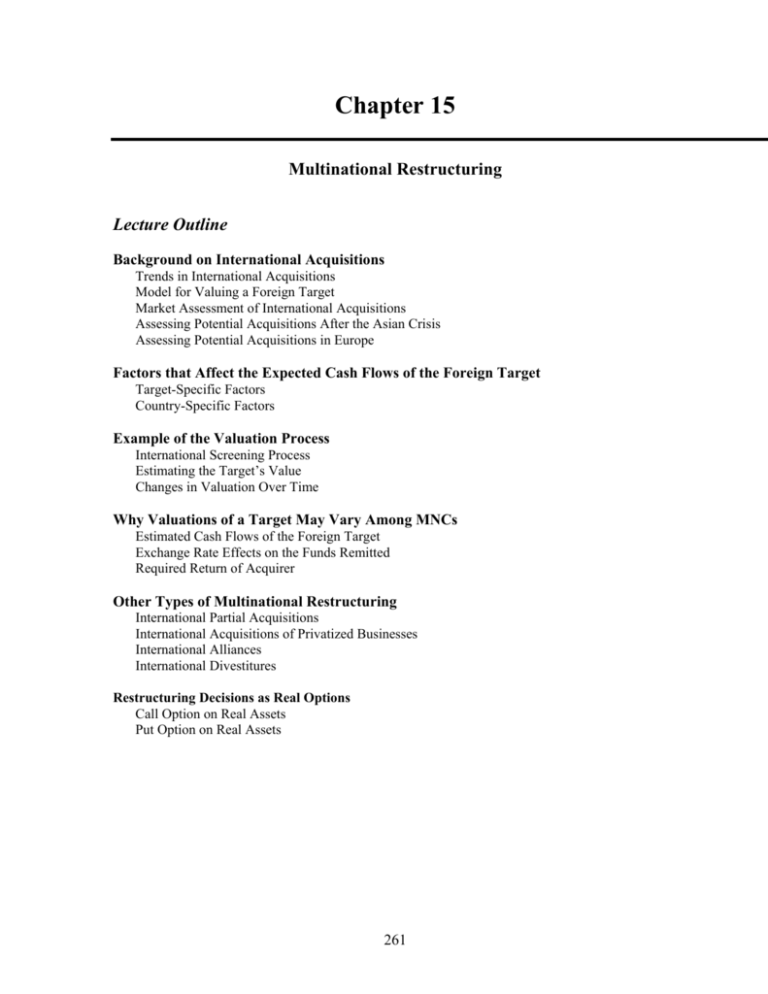
Chapter 15 Multinational Restructuring Lecture Outline Background on International Acquisitions Trends in International Acquisitions Model for Valuing a Foreign Target Market Assessment of International Acquisitions Assessing Potential Acquisitions After the Asian Crisis Assessing Potential Acquisitions in Europe Factors that Affect the Expected Cash Flows of the Foreign Target Target-Specific Factors Country-Specific Factors Example of the Valuation Process International Screening Process Estimating the Target’s Value Changes in Valuation Over Time Why Valuations of a Target May Vary Among MNCs Estimated Cash Flows of the Foreign Target Exchange Rate Effects on the Funds Remitted Required Return of Acquirer Other Types of Multinational Restructuring International Partial Acquisitions International Acquisitions of Privatized Businesses International Alliances International Divestitures Restructuring Decisions as Real Options Call Option on Real Assets Put Option on Real Assets 261 262 International Financial Management Chapter Theme This chapter emphasizes that the strategic plan of an MNC can be modified continuously in response to changing global conditions, and multinational restructuring may be needed to achieve the plan. Some of the more critical issues related to multinational restructuring are discussed. Topics to Stimulate Class Discussion 1. Why do MNCs consider multinational restructuring? 2. How should MNCs determine whether multinational restructuring is worthwhile? 3. What are common ways by which an MNC can conduct multinational restructuring? 4. What role does valuation play in the multinational restructuring process? POINT/COUNTER-POINT: Can a Foreign Target Be Assessed Like Any Other Asset? POINT: Yes. The value of a foreign target to an MNC is the present value of the future cash flows to the MNC. The process of estimating a foreign target’s value is the same as the process of estimating a machine’s value. A target has expected cash flows, which can be derived from information about previous cash flows. COUNTER-POINT: No. A target’s behavior will change after it is acquired by an MNC. Its efficiency may change depending on the ability of the MNC to integrate the target with its own operations. The morale of the target employees could either improve or worsen after the acquisition, depending on the treatment by the acquirer. Thus, a proper estimate of cash flows generated by the target must consider the changes in the target due to the acquisition. WHO IS CORRECT? Use the Internet to learn more about this issue. Which argument do you support? Offer your own opinion on this issue. ANSWER: Some targets may continue their business in the same manner as before, and their cash flows may not change significantly. Others are restructured due to the acquisition, so their cash flows might deviate substantially from before the acquisition. Answers to End of Chapter Questions 1. Motives for Restructuring. Why do you think MNCs continuously assess possible forms of multinational restructuring, such as foreign acquisitions or downsizing of a foreign subsidiary? ANSWER: MNCs continuously assess possible forms of multinational restructuring so that they can capitalize on changing economic, political, or industry conditions across countries. These conditions may present opportunities not available in the U.S. Chapter 15: Multinational Restructuring 263 2. Exposure to Country Regulations. Maude Inc., a U.S.-based MNC, has recently acquired a firm in Singapore. To eliminate inefficiencies, Maude downsized the target substantially, eliminating two-thirds of the workforce. Why might this action affect the regulations imposed on the subsidiary’s business by the Singapore government? ANSWER: One of the benefits of direct foreign investment from a host government’s viewpoint is the potential reduction of unemployment. If a U.S.-based MNC such as Maude contributes to growing unemployment in the host country, the government may impose special taxes or requirements that would render further expansion in Singapore undesirable. 3. Global Expansion Strategy. Poki Inc., a U.S.-based MNC, is considering expanding into Thailand because of decreasing profit margins in the U.S. The demand for Poki’s product in Thailand is very strong. However, forecasts indicate that the baht is expected to depreciate substantially over the next three years. Should Poki expand into Thailand? What factors may affect its decision? ANSWER: Poki faces a tradeoff. Demand for its product in Thailand is very strong, while it is deteriorating in the U.S. However, the baht is expected to depreciate substantially, which would reduce the dollar value of any baht remitted back to the parent. Poki’s decision should be affected by the amount of cash flows that is subject to the baht’s depreciation. If Poki plans to keep the funds in Thailand until the baht begins to appreciate again, it is not subject to the depreciation. Also, even if baht-denominated funds are remitted to the U.S. on a regular basis in periods when the baht is depreciating, the strong demand in Thailand may generate satisfactory profits; Poki may even be able to increase the price of its product. Poki may also consider investigating the demand for its product in other foreign countries whose currencies are not expected to depreciate. 4. Alternatives to International Acquisitions. Rastell Inc., a U.S.-based MNC, is considering the acquisition of a Russian target to produce personal computers (PCs) and market them throughout Russia, where demand for PCs has increased substantially in recent years. Assume that the stock market conditions are not favorable in Russia, as the stock prices of most Russian companies rose substantially just prior to Rastell’s assessment of the target. What are some alternatives available to Rastell? ANSWER: There are at least two alternatives available to Rastell Inc. First, it could enter into a licensing agreement with the Russian target to manufacture and distribute PCs with the Rastell name throughout Russia. Second, it could enter into a joint venture with the potential Russian target. Both of these methods would allow Rastell to access the Russian PC market. Furthermore, when stock prices in Russia decline, Rastell could make a bid for the potential Russian target. 5. Comparing International Projects. Savannah, Inc., a manufacturer of clothing, wants to increase its market share by acquiring a target producing a popular clothing line in Europe. This clothing line is well established. Forecasts indicate a relatively stable euro over the life of the project. Marquette, Inc., wants to increase its market share in the personal computer market by acquiring a target in Thailand that currently produces radios and converting the operations to produce PCs. Forecasts indicate a depreciation of the baht over the life of the project. Funds resulting from both projects will be remitted to the respective U.S. parent on a regular basis. Which target do you think will result in a higher net present value? Why? 264 International Financial Management ANSWER: The European target will likely result in a higher NPV. First, the euro has generally been more stable than the Thai baht. The Thai baht is expected to depreciate, which would result in a reduction in dollar cash flows remitted to Marquette, which would reduce the net present value associated with that project. Second, Savannah will likely continue the operations of the acquired European target, while Marquette will substantially change the target’s existing operations. Consequently, there is much greater uncertainty regarding the Thailand project, which would result in a higher required rate of return. A higher required rate of return will reduce the net present value associated with a project. 6. Privatized Business Valuations. Why are valuations of privatized businesses previously owned by the governments of developing countries more difficult than valuations of existing firms in developed countries? ANSWER: There are several reasons why the valuation of a privatized business may be more difficult than the valuation of an existing firm in a developed country. First, future cash flows associated with a privatized business are very uncertain because the businesses previously have been operating in environment of little or no competition. Second, there are very limited data in some of these countries. Third, economic conditions in these countries are very uncertain. Fourth, exchange rate estimates are very uncertain. Fifth, the cost of local financing for projects in developing countries is very uncertain. Sixth, the lack of established stock markets in developing countries prevents an MNC from deriving a value for a business based on comparable publicly held firms. Seventh, the government may retain part of the firm, which could lead to control conflicts in the future. 7. Valuing a Foreign Target. Blore Inc., a U.S.-based MNC, has screened several targets. Based on economic and political considerations, only one eligible target remains in Malaysia. Blore would like you to value this target and has provided you with the following information: • Blore expects to keep the target for three years, at which time it expects to sell the firm for 300 million Malaysian ringgit (MYR) after any taxes. • Blore expects a strong Malaysian economy. The estimates for revenue for the next year are MYR200 million. Revenues are expected to increase by 8% in each of the following two years. • Cost of goods sold are expected to be 50% of revenue. • Selling and administrative expenses are expected to be MYR30 million in each of the next three years. • The Malaysian tax rate on the target’s earnings is expected to be 35 percent. • Depreciation expenses are expected to be MYR20 million per year for each of the next three years. • The target will need MYR7 million in cash each year to support existing operations. • The target’s stock price is currently MYR30 per share. The target has 9 million shares outstanding. Chapter 15: Multinational Restructuring 265 • Any remaining cash flows will be remitted by the target to Blore Inc. Blore uses the prevailing exchange rate of the Malaysian ringgit as the expected exchange rate for the next three years. This exchange rate is currently $.25. • Blore’s required rate of return on similar projects is 20 percent. a. Prepare a worksheet to estimate the value of the Malaysian target based on the information provided. ANSWER: Valuation of Malaysian Target Based on the Assumptions Provided (numbers are in millions) Revenue Cost of Goods Sold Gross Profit Selling & Admin. Exp. Depreciation Earnings Before Taxes Tax (35%) Earnings After Taxes + Depreciation – Funds to Reinvest Year 1 Year 2 Year 3 MYR200 MYR100 MYR100 MYR216 MYR108 MYR108 MYR233.3 MYR116.6 MYR116.7 MYR30 MYR20 MYR50 MYR30 MYR20 MYR58 MYR30 MYR20 MYR66.7 MYR17.5 MYR32.5 MYR20.3 MYR37.7 MYR23.3 MYR43.4 MYR20 MYR7 MYR20 MYR7 MYR20 MYR7 Sale of Firm Cash Flows in MYR Exchange Rate of MYR Cash Flows in $ PV (20% disc. rate) Cumulative PV MYR300 MYR45.5 $.25 $11.4 MYR50.7 $.25 $12.7 MYR356.4 $.25 $89.1 $9.5 $9.5 $8.8 $18.3 $51.6 $69.9 The value of the Malaysian target based on the information provided is $69.9 million. b. Will Blore Inc. be able to acquire the Malaysian target for a price lower than its valuation of the target? ANSWER: The Malaysian target’s shares are presently valued at MYR30 per share. Thus, the 9 million shares outstanding are worth MYR270 million. At the prevailing exchange rate of $.25, the target is presently valued at $67.5 million (computed as MYR270 million × $.25). The MNC’s valuation of the target is $69.9 million, which is only about 3.5% above the market valuation. However, Blore will have to pay a premium on the shares to entice the target’s board of directors to approve the acquisition. Premiums commonly range from 10 percent to 40 percent 266 International Financial Management of the market price. Therefore, it is unlikely that Blore could purchase the target for a price that is below its valuation of the target. 8. Uncertainty Surrounding a Foreign Target. Refer to question 7. What are some of the key sources of uncertainty in Blore’s valuation of the target? Identify two reasons why the expected cash flows from an Asian subsidiary of a U.S.-based MNC would have been lower as a result of the Asian crisis. ANSWER: There is much uncertainty regarding the assumptions employed. For example, the growth rate in revenues may be overestimated if Blore has overestimated the growth rate of the Malaysian economy. The estimates of expenses may be inaccurate. Also, the exchange rate of the Malaysian ringgit may be weaker than what was assumed. Blore would prefer to purchase the target for an amount that is substantially less than its valuation of the target because it provides Blore with more of a cushion if the target’s value turns out to be less than what was estimated. 9. Divestiture Strategy. The reduction in expected cash flows of Asian subsidiaries as a result of the Asian crisis likely resulted in a reduced valuation of these subsidiaries from the parent’s perspective. Explain why a U.S.-based MNC might not have sold its Asian subsidiaries. ANSWER: The valuation of the subsidiaries would have declined because of the reduction in cash flows, so potential buyers may not have been willing to pay an amount that even reflects the present value of the expected future cash flows. Thus, the parent should have retained the subsidiaries if it could not sell them for an amount at least equal to their respective values. 10. Why a Foreign Acquisition May Backfire. Provide two reasons why an MNC’s strategy of acquiring a foreign target will backfire. That is, explain why the acquisition might result in a negative NPV. ANSWER: The MNC may overestimate the cash flows to be generated by the target, due to overestimating the revenues or underestimating the cost of operating the target. In addition, it may overestimate the future salvage value of the target. Advanced Questions 11. Pricing a Foreign Target. Alaska Inc. would like to acquire Estoya Corp., which is located in Peru. In initial negotiations, Estoya has asked for a purchase price of 1 billion Peruvian new sol. If Alaska completes the purchase, it would keep Estoya’s operations for two years and then sell the company. In the recent past, Estoya has generated annual cash flows of 500 million new sol per year, but Alaska believes that it can increase these cash flows by 5 percent each year by improving the operations of the plant. Given these improvements, Alaska believes it will be able to resell Estoya in two years for 1.2 billion new sol. The current exchange rate of the new sol is $.29, and exchange rate forecasts for the next two years indicate values of $.29 and $.27, respectively. Given these facts, should Alaska Inc. pay 1 billion new sol for Estoya Corp. if the required rate of return is 18 percent? What is the maximum price Alaska should be willing to pay? Chapter 15: Multinational Restructuring 267 ANSWER: Year Operating CF Sale of Estoya Cash flows in new sol Exchange rate Cash flows in $ PV (18% discount rate) Cumulative PV 0 1 525.00 525.00 $.29 $152.25 $129.03 $129.03 2 551.25 1,200.00 1,751.25 $.27 $472.84 $339.59 $468.62 Alaska, Inc. should not pay more than $468.62 million for Estoya Corp. Estoya is asking for 1.2 billion new sol, which translates to $348 million at the current exchange rate of $.29. Therefore, Alaska, Inc. should purchase Estoya Corp. 12. Global Strategy. Senser Co. established a subsidiary in Russia two years ago. Under its original plans, Senser intended to operate the subsidiary for a total of four years. However, it would like to reassess the situation, since exchange rate forecasts for the Russian ruble indicate that it may depreciate from its current level of $.033 to $.028 next year and to $.025 in the following year. Senser could sell the subsidiary today for 5 million rubles to a potential acquirer. If Senser continues to operate the subsidiary, it will generate cash flows of 3 million rubles next year and 4 million rubles in the following year. These cash flows would be remitted back to the parent in the U.S. The required rate of return of the project is 16 percent. Should Senser continue operating the Russian subsidiary? ANSWER: End of Year 2 Rubles remitted Selling price Exchange rate Cash flow from divestiture Cash flows forgone PV of forgone CF (16%) 5,000,000 $.033 $165,000 End of Year 3 3,000,000 End of Year 4 4,000,000 $.028 $.025 $84,000 $72,413.79 $100,000 $74,316.29 NPVd = $165,000 − ($72,413.79 + $74,316.29) = $18,269.92 Senser Co. should consider divesting its subsidiary, since the present value of the cash flows is less than the price it could sell the subsidiary for today. 13. Divestiture Decision. Colorado Springs Co. plans to divest either its Singapore or its Canadian subsidiary. Assume that if exchange rates remain constant, the dollar cash flows each of these subsidiaries would provide to the parent over time would be somewhat similar. However, the firm expects the Singapore dollar to depreciate against the U.S. dollar, and the Canadian dollar to appreciate against the U.S. dollar. The firm can sell either subsidiary for about the same price today. Which one should it sell? 268 International Financial Management ANSWER: It should sell the Singapore subsidiary because the forgone cash flows to the parent will be less. If the Singapore dollar depreciates, the dollar cash flows received by the parent will decline. 14. Divestiture Decision. San Gabriel Corp. recently considered divesting its Italian subsidiary and determined that the divestiture was not feasible. The required rate of return on this subsidiary was 17 percent. In the last week, San Gabriel’s required return on that subsidiary increased to 21 percent. If the sales price of the subsidiary has not changed, explain why the divestiture may now be feasible. ANSWER: As a project’s required rate of return increases, the present value of cash flows decreases. Also, the present value of foreign cash flows would decrease and may now be lower than the proceeds received from the divestitures. 15. Divestiture Decision. Ethridge Co. of Atlanta, Georgia has a subsidiary in India that produces products and sells them throughout Asia. In response to the September 11, 2001 terrorist attack on the U.S., Ethridge Co. decided to conduct a capital budgeting analysis to determine whether it should divest the subsidiary. Why might this decision be different after the attack as opposed to before the attack? Describe the general method for determining whether the divestiture is financially feasible. ANSWER: The divestiture decision may be different because cash flow estimates may have changed since the attack. Estimated revenue generated by its U.S. subsidiary may decline because of friction between the U.S. and some consumers in central Asia. In addition, the expenses associated with security and insurance would likely increase. However, the potential salvage value may have declined as a result of the attack also. The divestiture decision involves a comparison of the dollars that would be received from selling the subsidiary versus the present value of dollar costs associated with keeping the subsidiary. 16. Feasibility of a Divestiture. Merton Inc. has a subsidiary in Bulgaria that it fully finances with its own equity. Last week, a firm offered to buy the subsidiary from Merton Inc. for $60 million in cash and the offer is still available this week as well. The annualized long-term risk-free rate in the U.S. increased from 7% to 8% this week. The expected monthly cash flows to be generated by the subsidiary have not changed since last week. The risk premium that Merton Inc. applies to its projects in Bulgaria was reduced from 11.3% to 10.9% this week. The annualized long-term riskfree rate in Bulgaria declined from 23% to 21% this week. Would the NPV to Merton Inc. from divesting this unit be more or less than the NPV determined last week? Why? (No analysis is necessary, but make sure that your explanation is very clear.) ANSWER: The NPV of the divestiture would be higher because a higher discount rate would be used as the required rate of return applied to the subsidiary’s cash flows. The risk-free rate increased by 1% while the risk premium is reduced by .4%, so the required rate of return has increased by .6%. The present value of the forgone cash flows should be lower this week, which means that the NPV from divesting the unit should be higher. 17. Accounting for Government Restrictions. Sunbelt Inc. plans to purchase a firm in Indonesia. It believes that it can install its operating procedure in this firm, which would significantly reduce the firm’s operating expenses. However, the Indonesian government may approve the acquisition only if Sunbelt does not lay off any workers. How can Sunbelt possibly increase efficiency Chapter 15: Multinational Restructuring 269 without laying off workers? How can Sunbelt account for the Indonesian government’s position as it assesses the NPV of this possible acquisition? ANSWER: Sunbelt should first consider the profile of the workers who it would lay off if it could after improving the operations. Then, it could decide how it could revise the job descriptions so that those workers who are no longer needed for normal operations can be utilized in a different manner. Then, Sunbelt should estimate the NPV of this potential acquisition after considering these conditions. It may not be able to reduce labor expenses in the way that it desired if layoffs are prohibited, but it may achieve increased production, which could lead to higher revenue, and therefore the acquisition may be feasible. 18. Foreign Acquisition Decision. Florida Co. produces software. Its primary business in Boca Raton is expected to generate cash flows of $4,000,000 at the end of each of the next 3 years, and expects that it could sell this business for $10 million (after accounting for capital gains taxes) at the end of 3 years. Florida Co. also has a side business in Pompano Beach that takes the software created in Boca Raton and exports it to Europe. As long as the side business distributes this software to Europe, it is expected to generate $2 million in cash flows at the end of each of the next three years. This side business in Pompano Beach is separate from Florida’s main business. Recently, Florida was contacted by a Ryne Co. in Europe which specializes in distributing software throughout Europe. If Florida acquires Ryne Co., it would rely on Ryne instead of its side business to sell its software in Europe, because Ryne could easily reach all of Florida Company’s existing European customers and additional potential European customers. By acquiring Ryne, Florida would be able to sell much more software in Europe than it can sell with its side business, but it has to determine whether the acquisition would be feasible. The initial investment to acquire Ryne Co. would be $7 million. Ryne would generate 6 million euros per year in profits, and would be subject to a European tax rate of 40%. All after-tax profits would be remitted to Florida Co. at the end of each year and the profits would not be subject to any U.S taxes since they were already taxed in Europe. The spot rate of the euro is $1.10 and Florida Co. believes the spot rate is a reasonable forecast of future exchange rates. Florida Co. expects that it could sell Ryne Co. at the end of 3 years for 3 million euros (after accounting for any capital gains taxes). Florida Company’s required rate of return on the acquisition is 20%. Determine the net present value of this acquisition. Should Florida Co. acquire Ryne Co.? ANSWER: Year 0 Year 1 €6,000,000 €3,600,000 Year 2 €6,000,000 €3,600,000 $1.10 $1.10 Year 3 €6,000,000 €3,600,000 €3,000,000 $1.10 Cash flow to parent, ignoring impact on existing business $3,960,000 $3,960,000 $7,260,000 Impact on existing business –$2,000,000 –$2,000,000 –$2,000,000 Profit After tax (40%) Sale of company Rate 270 International Financial Management Year 0 Cash flow to parent, incorporating impact on existing business PV (20% discount rate) Initial investment Cumulative NPV Year 1 Year 2 Year 3 $1,960,000 $1,960,000 $5,260,000 $1,633,333 $1,361,111 $3,043,981 –$7,000,000 –$5,366,666 –$4,005,555 –$961,574 The acquisition will not be feasible, since it will require substantial initial investment, and will also eliminate the cash flows of the existing business. 19. Foreign Acquisition Decision. Minnesota Company consists of two businesses. Its local business is expected to generate cash flows of $1,000,000 at the end of each of the next 3 years. It also owns a foreign subsidiary based in Mexico, whose business is selling technology in Mexico. This business is expected to generate $2,000,000 in cash flows at the end of each of the next three years. The main competitor of the Mexican subsidiary is Perez Co., a privately-held firm that is based in Mexico. Minnesota Company just contacted Perez Co., and wants to acquire it. If it acquires Perez, Minnesota would merge the operations of Perez Co. with its Mexican subsidiary’s business. It expects that these merged operations in Mexico would generate a total of $3,000,000 in cash flows at the end of each of the next 3 years. Perez Co. is willing to be acquired for a price of 40 million pesos. The spot rate of the Mexican peso is $.10. The required rate of return on this project is 24%. Determine the net present value of this acquisition by Minnesota Company. Should Minnesota Company pursue this acquisition? ANSWER: Additional cash flows from acquiring Perez Required rate of return Present value of CF Year 1 Year 2 $1,000,000 0.24 $806,451 $1,000,000 0.24 $650,364 Year 3 $1,000,000 0.24 $524,487 The present value = $806,451 + $650,364 + $534,487 = $1,981,303 NPV = $1,981,303 – $4,000,000 = –$2,018,697 Minnesota should not pursue the acquisition. 20. Decision to Sell a Business. Kentucky Co. has an existing business in Italy that it is trying to sell. It receives one offer today from Rome Co. for $20 million (after capital gains taxes are paid). Alternatively, Venice Co. wants to buy the business, but will not have the funds to make the acquisition until 2 years from now. It is meeting with Kentucky Co. today to negotiate the acquisition price that it will guarantee for Kentucky in two years (the price would be backed by a reputable bank so there would be no concern about Venice Co. backing out of the agreement). If Kentucky Co. retains the business for the next two years, it expects that the business would generate 6 million euros per year in cash flows (after taxes are paid) at the end of each of the next Chapter 15: Multinational Restructuring 271 two years, which would be remitted to the U.S. The euro is presently $1.20 and that rate can be used as a forecast of future spot rates. Kentucky would only retain the business if it can earn a rate of return of at least 18% by keeping the firm for the next two years rather than selling it to Rome Co. now. Determine the minimum price in dollars at which Kentucky should be willing to sell its business (after accounting for capital gain taxes paid) to Venice Co. in order to satisfy its required rate of return. ANSWER: To determine the minimum price in dollars at which Kentucky Co. should be willing to sell the business two years from now, determine the NPV of its operation for the next two years. The calculations below show the NPV of the future cash flows is $11,272,623. Cash flow in euro Rate Cash flow to the parent company PV of parent cash flows (18% discount rate) Cumulative NPV Year 1 €6,000,000 $1.20 $7,200,000 Year 2 €6,000,000 $1.20 $7,200,000 $6,101,695 $5,170,928 $11,272,623 Kentucky Co. should be willing to sell its business in two years for no less than the difference between the $20,000,000 offer today and the NPV, with an adjustment for the time value of money: $20,000,000 – $11,272,623 = $8,727,377 Since the money would not be received for 2 years, Kentucky Co. would need to receive a larger amount to reflect its required rate of return on the funds over the next 2 years. Based on an 18% required rate of return, it would take an acquisition price of $12,193,772 in two years to equal $8,727,377 today. 21. Foreign Divestiture Decision. Baltimore Co. considers divesting its six foreign projects as of today. Each project will last one year. Its required rate of return on each project is the same. The cost of operations for each project is denominated in dollars and is the same. Baltimore believes that each project will generate the equivalent of $10 million in one year based on today’s exchange rate. However, each project generates its cash flow in a different currency. Baltimore believes that interest rate parity (IRP) exists. Baltimore forecasts exchange rates as explained in the table below. a. Based on this information, which project will Baltimore be most likely to divest? Why? b. Based on this information, which project will Baltimore be least likely to divest? Why? 272 International Financial Management Project Country A Country B Country C Country D Country E Country F Comparison of One-year U.S. and Foreign Interest Rates The U.S. interest rate is higher than currency A’s interest rate The U.S interest rate is higher than currency B’s interest rate The U.S. interest rate is the same as currency C’s interest rate The U.S. interest rate is the same as Currency D’s interest rate The U.S. interest rate is lower than Currency E’s interest rate The U.S. interest rate is lower than Currency F’s interest rate Forecast Method Used to Forecast the Spot Rate One Year from Now Spot rate Forward rate Forward rate Spot rate Forward rate Spot rate ANSWER: a. Baltimore will be most likely to divest the project in country E because it anticipates depreciation of currency E, and no other currency is expected to depreciate. The depreciation of the currency will reduce the dollar cash flows, so this project is less desirable than other projects. b. Baltimore is least likely to divest the project in country B because it anticipates appreciation of currency B, and no other currency is expected to appreciate. The appreciation of the currency will increase the dollar cash flows, so this project is less desirable than other projects. 22. Factors that Affect the NPV of a Divestiture. Washington Co. (a U.S. firm) has a subsidiary in Germany that generates substantial earnings in euros each year. One week ago, it received an offer from a company to purchase it, and it has not yet responded to this offer. a. Since last week, the expected stream of euro cash flows has not changed, but the forecasts of the euro’s value in future periods have been revised downward. Will the NPV of the divestiture be larger or smaller or the same as it was last week? Briefly explain. b. Since last week, the expected stream of euro cash flows has not changed, but the long-term interest rate in the U.S. has declined. Will the NPV of the divestiture be larger or smaller or the same as it was last week? Briefly explain. ANSWER: a. Larger, because what the firm gives up is reduced. b. Smaller, because the PV of what the firm gives up is increased. Chapter 15: Multinational Restructuring 273 23. Impact of Country Perspective on Target Valuation. Targ Co. of the U.S. has been targeted by three firms that consider acquiring it: (1) Americo (from the U.S.), Japino (of Japan), and Canzo (of Canada). These three firms do not have any other international business, have similar risk levels, and have a similar capital structure. Each of the three potential acquirers has derived similar expected dollar cash flow estimates for Targ Co. The long-term risk free interest rate is 6% in the U.S., 9% in Canada, and 3% in Japan. The stock market conditions are similar in each of the countries. There are no potential country risk problems that would result from acquiring Targ Co. All potential acquirers expect that the Canadian dollar will appreciate by 1 percent a year against the U.S. dollar and will be stable against the Japanese yen. Which firm will likely have the highest valuation of Targ Co.? Explain. ANSWER: Japan firm has lowest cost of capital, so the present value of cash flows will be highest from that perspective. Solution to Continuing Case Problem: Blades, Inc. 1. Using a spreadsheet, determine the NPV of the acquisition of Skates’n’Stuff. Based on your numerical analysis, should Blades establish a subsidiary in Thailand or acquire Skates’n’Stuff? ANSWER: (See spreadsheet attached.) The analysis indicates that the acquisition will result in a net present value (NPV) of $6,641,949 to Blades, Inc. after accounting for the cost of the acquisition. Thus, the establishment of a new subsidiary in Thailand would be more profitable by $8,746,688 – $6,641,949 = $2,104,739. 2. If Blades negotiates with Skates’n’Stuff, what is the maximum amount (in Thai baht) Blades should be willing to pay? ANSWER: If Blades, Inc. were to negotiate with Skates’n’Stuff, it should attempt to pay a price that would render the acquisition of Skates’n’Stuff more attractive (in terms of net present value) than the establishment of a subsidiary. Since the difference in NPVs between the two options is $2,104,739, Blades, Inc. should attempt to reduce the purchase price by $2,104,739/$0.023 = 91,510,391 Thai baht. Consequently, it should offer a maximum of THB1,000,000,000 – THB91,510,391 = THB908,489,609 for Skates’n’Stuff. 3. Are there any other factors Blades should consider in making its decision? In your answer, you should consider the price Skates’n’Stuff is asking relative to your analysis in question 1, other potential businesses for sale in Thailand, the source of the information your analysis is based on, the production process that will be employed by the target in the future, and the future management of Skates’n’Stuff. ANSWER: Yes, there are other factors Blades, Inc. should consider in reaching its decision. First, Blades did not previously consider the acquisition of an existing business in Thailand. There may be other, more attractive, roller blade manufacturers for sale that Blades has not yet considered. Second, Blades should investigate the reason Skates’n’Stuff wants to sell its operations. Based on the low price the company is asking compared to Blades’ analysis (see question 1), the company’s outlook seems to be unfavorable. Third, the assumptions gathered by Ben Holt rely on information from unaudited financial statements, and the accuracy of these numbers may be questionable. Fourth, Blades should consider whether the lower quality of the roller blades manufactured by the existing Skates’n’Stuff plant will hurt its international reputation in the long 274 International Financial Management run, given its high-quality roller blades in the U.S. This is of particular concern if Blades is contemplating the sale of some of the roller blades produced in Thailand in the U.S., where the quality of its roller blades is higher. Fifth, Blades Inc. has to consider the management of Skates’n’Stuff after the acquisition. For example, Blades may maintain the existing employees of Skates’n’Stuff but restructure the operations in a manner that would increase the quality of the roller blades produced there. 1. Units Sold to Retailers in Thailand 2. Price per Unit (in Thai baht) 3. Revenue from Sales to Retailers in Thailand = (1) × (2) (in 000s) 4. Variable Cost per Unit (in Thai baht) 5. Total Variable Cost = (1) × (4) (in 000s) 6. Less Cost Savings from Production of 108,000 Pairs in Thailand (000s) 7. Fixed Operating Expenses (in Thai baht 000s) 8. Noncash Expense (Depreciation in baht 000s) 9. Total Expenses = (5) – (6) + (7) + (8) (in baht 000s) 10. Before-Tax Earnings of Subsidiary = (3) – (9) (in baht 000s) 11. Host Government Tax (25%) (in 000s) 12. After-Tax Earnings of Subsidiary 13. Net Cash Flow to Subsidiary = (12) + (8) (in baht 000s) 14. Thai Baht Remitted by Subsidiary (100% of CF) (in baht 000s) 15. Withholding Tax on Remitted Funds (10%) (in baht 000s) 16. Thai Baht Remitted After Withholding Taxes (in 000s) 17. Salvage Value (000s) 18. Exchange Rate of Thai Baht ($) 19. $ Cash Flow to Parent = (16) × (18) 20. PV of Parent Cash Flows (25% Discount Rate) 21. Initial $ Investment by Blades 22. Cumulative PV ($ 000s) Year 0 280,000 4,500 Year 1 280,000 5,040 Year 2 280,000 5,645 Year 3 280,000 6,322 Year 4 280,000 7,081 Year 5 280,000 7,931 Year 6 280,000 8,882 Year 7 280,000 9,948 Year 8 280,000 11,142 Year 9 280,000 12,479 Year 10 280,000 13,976 1,260,000 1,411,200 1,580,544 1,770,209 1,982,634 2,220,551 2,487,017 2,785,459 3,119,714 3,494,079 3,500 3,920 4,390 4,917 5,507 6,168 6,908 7,737 8,666 9,706 980,000 1,097,600 1,229,312 1,376,829 1,542,049 1,727,095 1,934,346 2,166,468 2,426,444 2,717,617 3,913,369 10,870 3,043,731 32,400 32,400 — — — — — — — — — 20,000 22,400 25,088 28,099 31,470 35,247 39,476 44,214 49,519 55,462 62,117 60,000 60,000 60,000 60,000 60,000 60,000 60,000 60,000 60,000 60,000 60,000 1,027,600 1,147,600 1,314,400 1,464,928 1,633,519 1,822,342 2,033,823 2,270,681 2,535,963 2,833,079 3,165,848 232,400 58,100 174,300 263,600 65,900 197,700 266,144 66,536 199,608 305,281 76,320 228,961 349,115 87,279 261,836 398,209 99,552 298,657 453,194 113,298 339,895 514,777 128,694 386,083 583,750 145,938 437,813 661,000 165,250 495,750 747,521 186,880 560,640 234,300 257,700 259,608 288,961 321,836 358,657 399,895 446,083 497,813 555,750 620,640 234,300 257,700 259,608 288,961 321,836 358,657 399,895 446,083 497,813 555,750 620,640 23,430 25,770 25,961 28,896 32,184 35,866 39,990 44,608 49,781 55,575 62,064 210,870 231,930 233,647 260,065 289,653 322,791 359,906 401,475 448,032 500,175 558,576 1,100,000 0.01879 31,169,086 0.02300 0.02254 0.02209 0.02165 0.02121 0.02079 0.02037 0.01997 0.01957 0.01918 4,850,010 5,227,702 5,161,080 5,629,732 6,144,827 6,710,882 7,332,857 8,016,198 8,766,879 9,591,461 4,850,010 4,182,162 3,303,091 2,882,423 2,516,921 2,199,022 1,922,265 1,681,119 1,470,838 1,287,344 23,000,000 (18,150) (13,968) (10,665) (7,782) (5,265) (3,066) (1,144) 537 2,008 3,295 3,346,755 6,642 276 International Financial Management Solution to Supplemental Case: Redwing Technology Company a. The earnings performance translated in dollars is misleading because they are distorted by varying exchange rates. The actual earnings in each local currency in each subsidiary should be assessed, since the subsidiary has no control over the exchange rate used for translation. The translation causes earnings to be overstated when the local currency is strong (against the dollar) and understated when the local currency is weak. The following table shows the earnings of each subsidiary when measured in the local currency. Based on this table, the Canadian subsidiary experienced a consistent growth in earnings over time, averaging about a 14 percent increase per year. Conversely, the South African subsidiary experienced consistent declines in earnings over time, with an average annual earnings growth rate of –4.38%. The Japanese subsidiary experienced a decline in earnings in all but one year, and its average annual earnings growth rate was –1.03%. When measured in this way, the executive in charge of the Canadian subsidiary appears to have achieved the best performance. The results are much different when earnings are measured in U.S. dollars for all subsidiaries. The Canadian performance would not be as high while the South African and Japanese performance would be higher. Yet, the chief executives of the respective subsidiaries cannot control the translated exchange rate. It can be argued that they should not be rewarded or penalized because of the translation effect caused by a volatile exchange rate (although there could be exceptions when they are personally responsible for hedging any remitted earnings or any inflows of funds coming from other countries). Earnings (in millions) Denominated in the Local Currency Years Ago 5 4 3 2 1 Canada C$16.80 19.92 22.68 25.92 28.44 Annual Percentage Increase — 18.57% 13.85 14.28 9.72 South Africa R210.00 200.00 187.50 180.00 175.00 Annual Percentage Increase — –4.76% –6.25 –3.74 –2.78 Japan Y7,500.00 7,441.86 7,608.69 7,454.54 7,187.50 Annual Percentage Increase — –.77% 2.24 –2.03 –3.58 b. Based on its high annual growth rate of earnings, the Canadian subsidiary would likely deserve a cash infusion from the parent to push for additional growth. The parent would probably feel that its funds are more likely to generate decent returns there than in other countries. c. Even if the earnings are remitted, Canada would still be the best bet. There was an assumption that last year’s exchange rate would be a reasonable guess for exchange rates in future years for each currency. This means that the parent will invest funds at the same exchange rate as the rate in which subsidiary earnings will be converted back to dollars in the future, for each subsidiary. Thus, no subsidiary is expected to have an exchange rate advantage over the others. d. The earnings of the Canadian and South African subsidiaries only appear to be highly correlated when translated in U.S. dollars. Their earnings in local currencies were not highly correlated. Thus, some diversification benefits would be lost if the Canadian subsidiary was sold (not to mention that it is the best-performing subsidiary) or if the South African subsidiary was sold. Chapter 15: Multinational Restructuring 277 Small Business Dilemma Multinational Restructuring by the Sports Exports Company 1. Are there any reasons why the business that has been so successful in the United Kingdom will not necessarily be successful in other European countries? ANSWER: When this business was first created, it was based on a perception that British consumers would become more interested in U.S. football, and that American-style football would become a popular hobby in the United Kingdom. However, Jim should consider whether the other European countries have similar characteristics before spreading the business throughout Europe. 2. If the business is diversified throughout Europe, will this substantially reduce the exposure of the Sports Exports Company to exchange rate risk? ANSWER: No. The European expansion will result in payments of euros for the exports. So the receivables will be pounds and euros, which tend to move in the same direction against the dollar. Furthermore, the extra European business will result in a larger absolute amount of business that is subject to exchange rate risk. 3. Now that several countries in Europe participate in a single currency system, will this affect the performance of new expansion throughout Europe? ANSWER: It may make it easier for the distributor to deal with stores throughout Europe, but the Sports Exports Company will still be exposed to exchange rate risk.


